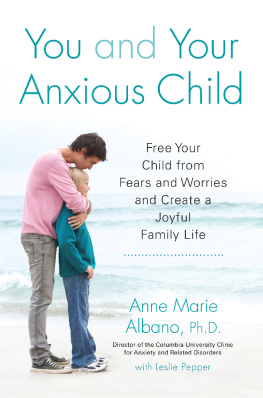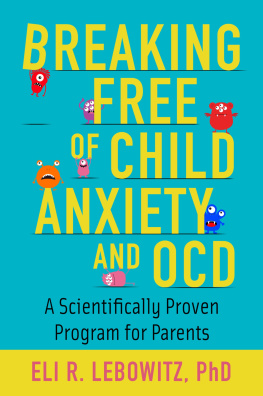The anxiety management principles and program described in this book are based on the clinical treatment program, Cool Kids, developed at Macquarie University, Sydney, Australia. Cool Kids is an evolving program that is based on many years of scientific research, theory, and clinical feedback. These developments could not have come without the invaluable input from a countless number of researchers and practitioners. It is simply not possible to mention or thank all the many people who have influenced this program. However, special thanks for the most recent developments go to Maree Abbott, Jennie Hudson, Susan Kennedy, Carolyn Schniering, and Viviana Wuthrich. We would also like to acknowledge the pioneering work of Paula Barrett, Mark Dadds, and Phil Kendall.
Appendix
Relaxation
All children experience physical tension in response to stressful events at some time in their lives. Stomachaches, headaches, sleep difficulties, and muscle pains can be related to very high levels of physical tension. Feelings like these can make it difficult for children to use appropriate coping skills, such as detective thinking, as children are too tense to concentrate on using the skills. If your child experiences a high level of physical tension, it may be helpful to teach him or her how to reduce these physical feelings to a level that allows use of the coping skills.
One strategy that children can use to reduce physical tension is relaxation. During relaxation, our bodys reactions change so that our heartbeat slows down and our muscle tension decreases. Signs of muscle tightness, such as headaches, gradually disappear. An added advantage is that our thoughts become calm and peaceful, blocking out anxious and worrying issues. These reductions in body tension and worrisome thoughts produce an emotional feeling of calmness and well-being. Its difficult to feel really anxious at the same time that you feel really relaxed. Relaxation might be especially useful for those children who simply cant do the detective thinking.
Some of the different ways that children can learn to relax include listening to soothing, peaceful music; meditation; relaxing imagery; muscle relaxation exercises; deep-breathing exercises; yoga; and massage. We are going to describe one particular method of relaxation that many children and their parents find effective. One of the best ways to teach children how to relax is to have the whole family involved in practicing and using the relaxation exercises. The method that is presented here combines a variety of techniques, and you may want to adapt the exercises to suit you and your family.
Teaching Your Child to Relax
Before you start to teach your child how to relax, there are a few points that we need to discuss and that will help you in these teaching sessions.
Relaxation Is a Skill
Like all new skills, relaxation exercises have to be practiced regularly in order to be performed well. You and your child will need to practice every day. To encourage you to practice regularly, we ask you to keep a record of your practice sessions. It is important to fill in a relaxation practice record every time you practice (every day). Suitable forms are included in the workbook at www.ceh.mq.edu.au/hyac.html, or you can create your own using the instructions in the Optional Activity 1 (p. 274). Its a good idea to keep the form in a clearly visible place where you are likely to see it each day (such as the refrigerator). This will help remind both you and your child to do the relaxation practice.
Teaching your child to relax also involves starting at the beginning, teaching the simple steps first. Then, when these can be performed well, you can move on to teaching more complex relaxation skills. It will probably take at least a week of daily practice for your child to relax well. After that, it is important to keep up daily practice while you go through the other steps in this appendix. Relaxation will be a useful technique for children to use when they are trying out some of their anxiety management skills later on.
Pick the Right Time
There are several things that you can do to make learning to relax an enjoyable activity. It is important to pick the right time to practice. We suggest that you pick a time when there are no other important things to do. For example, dont pick a time when your childs favorite TV show is on. Many families decide to get up ten to fifteen minutes earlier each day to do their relaxation practice. Others may set aside time before their child goes to bed. Before bed is often a convenient time, but you need to make sure that your child isnt too tired and therefore unable to concentrate on learning the skills. Using relaxation as a way to get to sleep is fine, but practicing relaxation needs to be done at a time when your child can concentrate.
Making the Time
It is easy to allow relaxation practice to be pushed out by other activities such as homework, sports, TV, and just general living. Setting aside a regular time for relaxation benefits the whole family. It makes everyone in the family aware that life can easily be taken over by the kind of rushing around that makes us forget to look after our emotional well-being.
Creating a Habit
One of the best ways of making sure that relaxation practice takes place is to set up a daily habit. Gradually, relaxation will become an automatic activity that is built into the family routinea daily habit in the same way that brushing our teeth is an automatic task. Try not to start missing days, and have a stand-by time that can be used if your regular practice time is not possible.
Creating a Relaxing Environment
When your child is learning to relax, you need to create an environment that will encourage relaxation. The area needs to be quiet and one where you will not be disturbed. You may want to take the phone off the hook or put the answering machine on. If you are thinking of inviting visitors over, make sure that it wont conflict with relaxation practice. The place of practice needs to be warm and comfortable. You can use a bed, a comfortable chair, or a mat on the floor. But if you use a bed, make sure you and your child do not fall asleep. Relaxation practice is easier if you and your child are wearing comfortable, casual clothes. Some families like to put on some quiet, calming music. Children respond well to relaxation music, and it may be useful to set the scene for practice by putting this type of music on in the background.
Use Praise and Make It Fun
As with all the methods in this book, you will need to use plenty of praise to encourage your child to practice and use the skills. Remember to give praise for trying, not just for succeeding in relaxation. As much as possible, try to make relaxation time an enjoyable, fun experience. There are plenty of ways to make relaxation practice interesting. In some of the steps, you will be using imagery where children can imagine themselves in peaceful, relaxing situations. You can use wonderful examples here of situations that children will love, such as magical islands, secret gardens, sailing ships, and so on. These will all help to make the sessions interesting and enjoyable.
Keep It Simple and Short
Children tend to lose interest quickly and find it hard to pay attention for long periods. With young children, it is better to practice more often for shorter periods, such as five minutes at a time. You also need to use simple language (as we have done in the sample script below) so that your child can understand the instructions.
Teaching by Example
In Steps to Relaxation, below, you will find a series of steps for learning relaxation skills. Depending on the age of your child, you will probably need to be the teacher of these skills. Some older children and adolescents find it difficult to accept instructions and guidance from their parents and prefer to read through the book and practice the skills on their own. However, one of the best ways to teach young children how to relax is to show them how to perform each step. This involves actually demonstrating each step by doing it yourself. It is really important that with each step you explain out loud exactly what you are doing and why you are doing it. That way, children gradually learn to say these instructions to themselves quietly and can eventually instruct themselves to use the relaxation methods.











